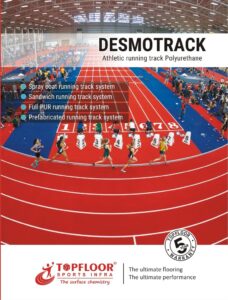Sandwich Running Track System
Topfloor Sports Infra is an athletics company that provides the best sports tracks and ground infrastructure. We provide Sandwich Running Athletics Track built in accordance with international Standards Organizations. Topfloor Sports Infra has all the know-how and technology to complete Sandwich Running Athletics Track construction in a timely manner.
We can assist with site surveys, planning and designs, soil investigation reporting, and much more for any sports track construction project, whether it is for an elite international competition facility or a local school or athletics club.
Synthetic athletic tracks can be found in a wide variety of forms, but can be roughly broken down into two classes: Permeable and Impermeable
If you’re interested in learning more about how we may assist you, please get in touch.

Main Construction Steps
- Primer and rubber elastic Layer paving
- FulL-PU material with EPDM powder for sealing on the rubber surface
- FulL-PU material for middle Layer coating
- FulL-PU surface layer coating with EPDM broadcast or Spray-coat Layer on top



Specification
Primer Layer
PU Binder
Rubber Base Elastic Layer
PU Binder Recycle Rubber Granule
Seal Layer
Red Full-PU Material
Red EPDM Powder
Surface Broadcast Layer
Red Full-PU Material
Red EPDM Granule (1-4mm)
Surface Spray-coat Layer
Red PU Spray-coat Material
Red EPDM Granule (0.5-2mm, 1-3mm, 1-4mm)
Other color option
Surface Self Texture Create
Spray-coat Layer
Red PU Self Textue Create Material
Color Protect Layer (Optional)
Colorful Si-PU Surface Layer Material
How is an Sandwich Running Athletics Track Built?
There are two phases involved in the creation of an Sandwich Running Athletics Track.
The first stage consists of asphalt or concrete pavement while the second stage comprises of synthetic material pavement.
Stage 1: Laying asphalt or concrete pavement
The measures are used to level the runway area. A roller is used to pack down the dirt, and a 10 cm layer of “finisher” plumbing filler is placed on a slope that works. This filler is “coarse crushed stone,” which is made up of rocks and grit that don’t fit through a NO 4 (4.75 mm) sieve. After that, a material called “fine chippings” that goes through screen No. 4 (4.75 mm) is put on top of the “filler.”
After being mixed with water, these two layers of plant mix are dried out, made hard, and then pressed with rollers. There is a good slope on the inside edge of the sports track so that water can drain away. It is 6 cm thick and is made up of asphalt, mineral material, mineral fillers, and asphalt binder with all of its “asphalt binder layers.” Then, a wear layer is put down. This is made of a hot mix of binder, asphalt cement based on crude oil, and mineral material. When the wear layer is put on again, the processes of breaking, compressing, and straightening begin. A slope of 0.5 to 0.7% is put on the inner line of the runway to keep water from building up, and a water path with a cover is put in this area.
Moreover, DIN 18035 says that if there are code differences on the ground that cause changes of more than 3 mm in the 4 m plane, these areas must be filled with a mix of pure polyurethane and quartz sand before the synthetic coating is applied, and the runway must be made completely level.
It is best to use asphalt first, but if that isn’t possible, concrete can be used instead.
If you want to use concrete as the base, you should use BS 18 concrete that meets Turkish standards. At least 360 kilograms of cement should be mixed with the gravel and cement to make it stronger against heat and load. To make the concrete floor stronger, steel mesh made of Q131 material should be added to the concrete. The whole floor should be 10 cm thick of concrete. Once the casting process is done and the surface has enough slope in the right direction, it should be cleaned to make it smooth. In this 4-meter line, there shouldn’t be any changes bigger than 3 mm. Applications for self-leveling screed should be used to fix areas that have more mistakes than what is allowed by international standards. Once the concrete’s moisture level drops to 5%, synthetic flooring can be put down.
Stage 2: Laying Synthetic Material Pavement
The second step in making a sandwich running track system is to follow certain rules and criteria. To do this, methods based on German Standard DIN-18035/6 and International Association of Athletics Federations (IAAF) standards are used to cover the floors. Putting primer on the substrate is the first step in making the synthetic substrate.
Once this layer is dry, special machines are used to put down an elastic layer of SBR granules that are 1–3 mm in diameter and bonded with a polyurethane prepolymer (binder) that is chosen based on the temperature. After that, the 10 mm layer of rubber is hardened. Spread out on the floor will be black SR granules mixed with one layer of two-component polyurethane. This will fill in the holes left by the last layer. After the areas that need to be changed are finished being worked on, a 3 mm layer of title-colored polyurethane glue should be put on top of the base system.
It’s best to sprinkle EPDM granules on the floor while this layer is still not fully hardened. These granules should have a width of 1-4 mm, a tensile strength of 7.0 N/mm, a breaking elongation of >650%, a hardness degree of Shore A 62, and an ozone resistance of 200 PPHM. Now that this part is done, the synthetic covering should be 13 mm thick.
Cost for a Sandwich-Design Athletics Track
The cost of building a Sandwich Running Athletics Track depends on a number of factors, including what kind of ground is being utilized, how big the site is, and where it is going to be constructed.
To know the pricing appropriate to your project, you can get an offer from us by specifying the parameters.
At Topfloor Sports Infra, we have the technology it takes to make the perfect sandwich running athletic track. We built these tracks for both Sports complexes and School and college tracks.
What are the advantages of Sandwich Running Athletics Track?
- It has a thickness of 13 millimeters.
- It has three distinct levels.
- To complete the set, SBR, PU, and 100% authentic EPDM are incorporated.
- Build for perfect shock absorption.
- It has great resistance to wear and tear.
- It can be worn with cleats.
- With its strong UV protection, it provides years of comfort without fading.
- Both extremely hot and extremely cold places can benefit from it.
- Water cannot penetrate the surface, and any that does is quickly shed.
- The price of upkeep is minimal.
- Professional athletic events use this surface.
- The concept of a sandwich system has been baffling me.
- The sandwich system is used in professional sports.
- It’s a rubber-and-binder-and-polyurethane-based flooring material.
FAQ's
It is laid down on jogging and running tracks at the professional level.
A finisher machine applies black SBR rubber granules of 10mm thickness to the asphalt surface, followed by the pouring of polyurethane material and the pouring of approximately 4 kg/m2 EPDM granules, followed by a 1-day wait. The land is then swept and marked off.
It is a form of rubber-polyurethane substance obtained from recycled material.
Color and size are two factors that affect the project’s final cost.
Sandwich Running Athletics Track’s three properties—UV resistance and flexibility—make it ideal for athletic tracks and pedestrian routes.



